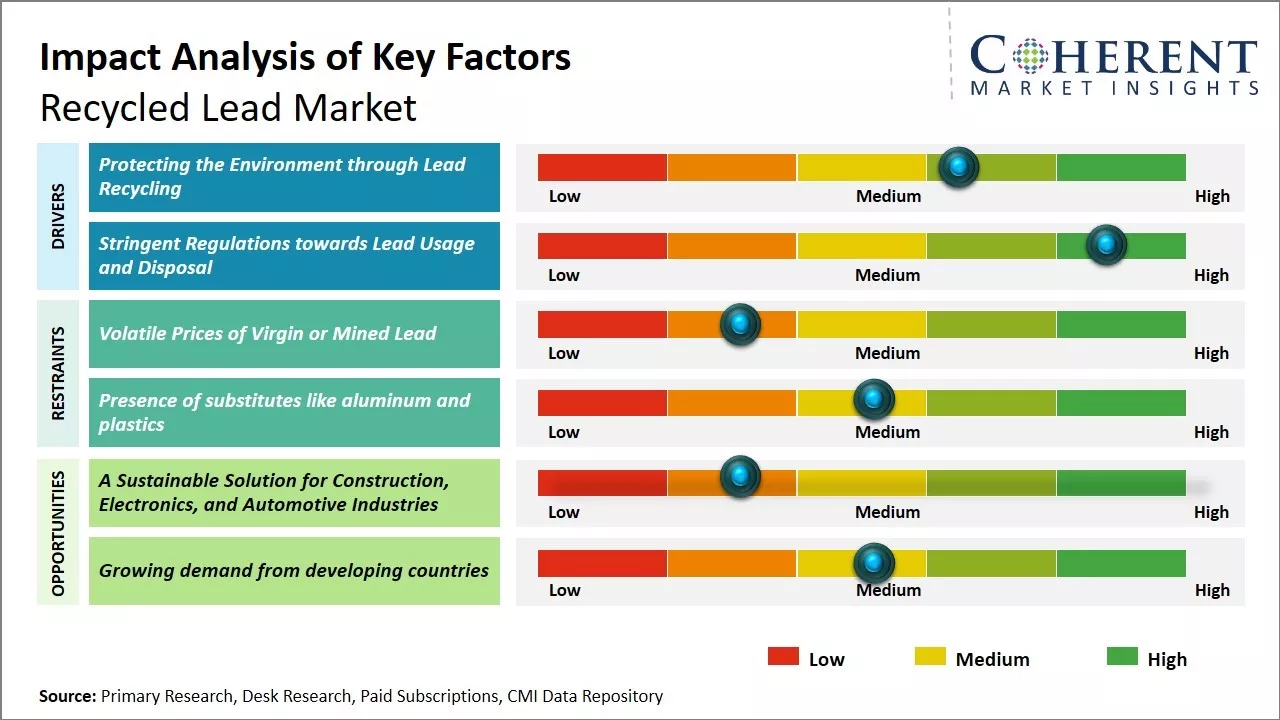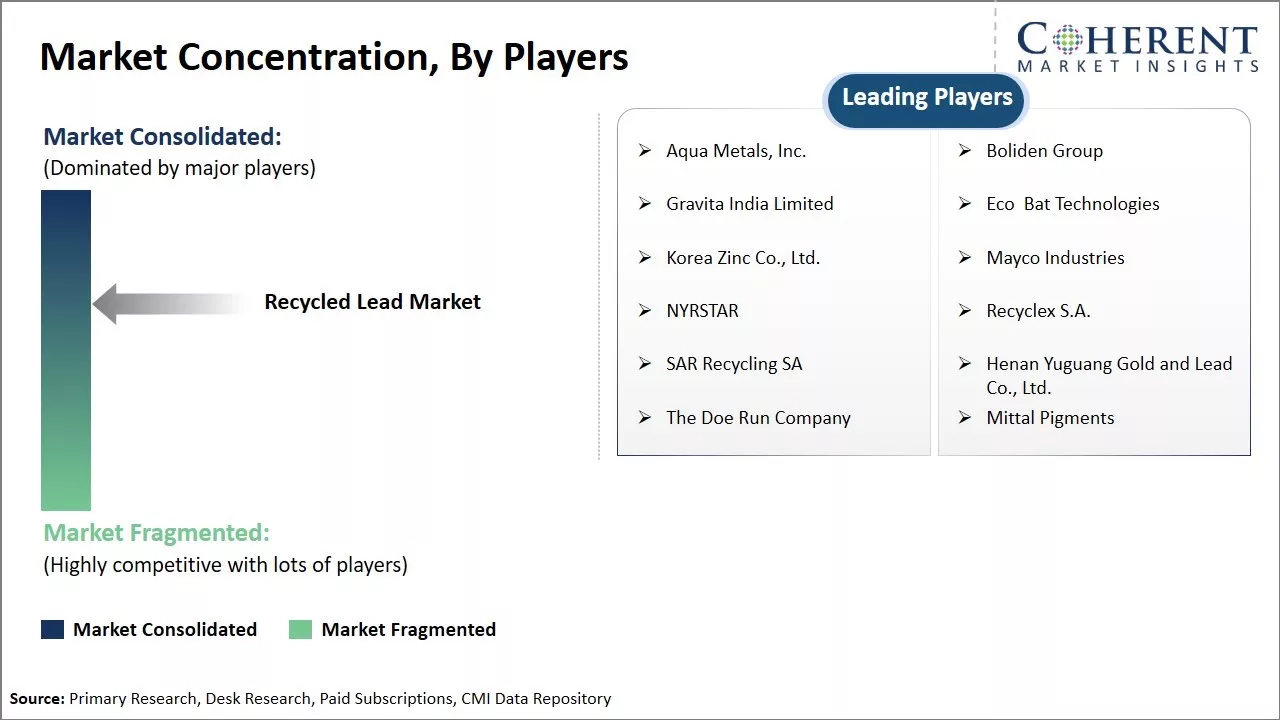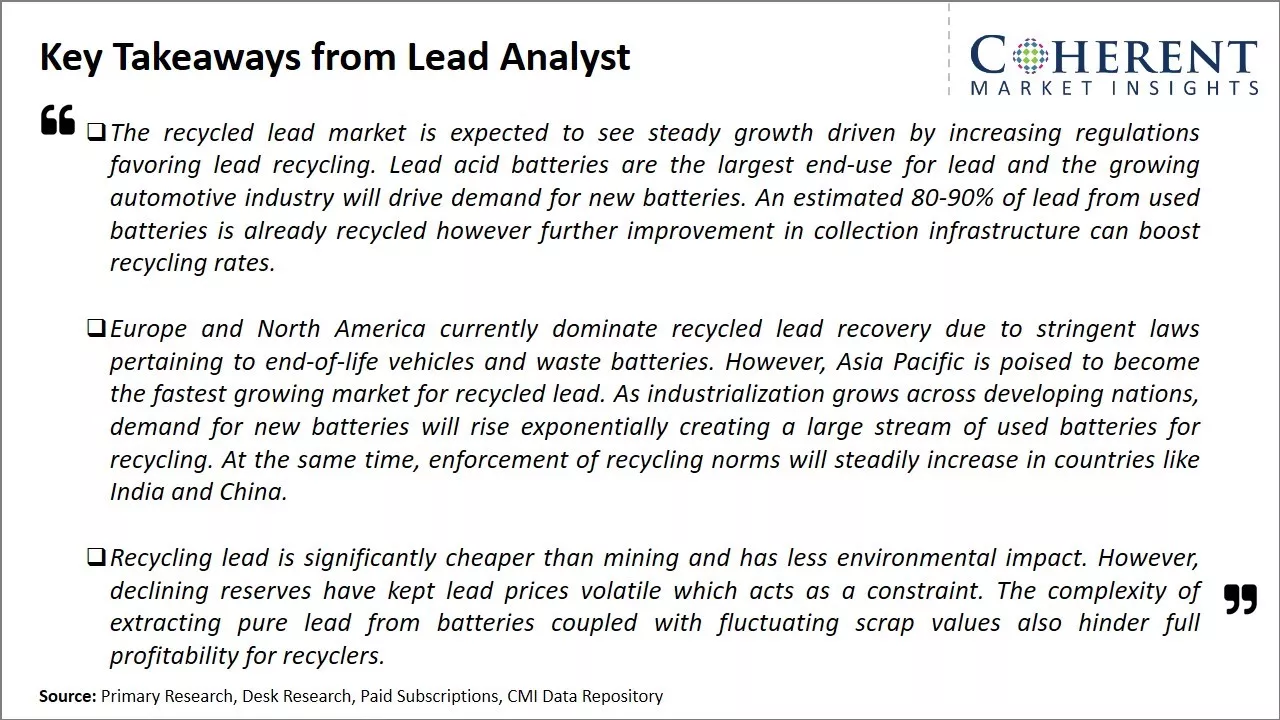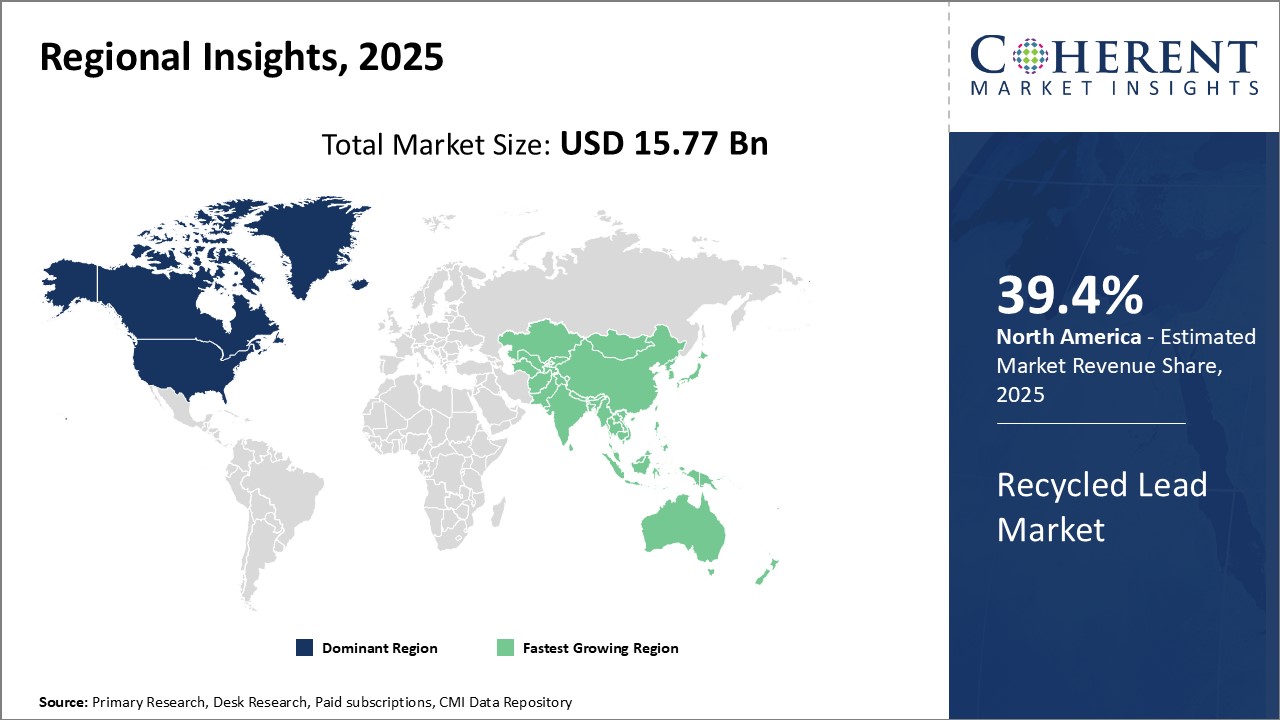Recycled Lead Market Size and Trends
Global recycled lead market is estimated to be valued at USD 15.77 Bn in 2025 and is expected to reach USD 20.76 Bn by 2032, exhibiting a compound annual growth rate (CAGR) of 4.0% from 2025 to 2032.

Discover market dynamics shaping the industry: Download Free Sample
The demand for recycled lead is expected to increase significantly over the forecast period. The market growth is driven by rising environmental concerns and implementation of stringent regulations regarding lead waste disposal. Regulations in major regions are promoting the use of recycled lead over primary lead to reduce environmental footprint. Growing awareness about the toxic effects of improper lead disposal is also compelling industries such as battery manufacturers to increase recycled lead consumption. If regulatory support and disposal norms are strengthened further, the recycled lead market is likely to experience strong growth momentum between 2025-2032.
Protecting the Environment through Lead Recycling
As environmental concerns continue to rise to the forefront of public discussion, issues of sustainability and reducing industrial waste have become increasingly important to address. One pivotal aspect of achieving greater sustainability is boosting recycling rates for materials that can be reused. Lead acid batteries, used widely in automotive and other applications, represent a major potential source for lead recycling. When these batteries reach the end of their useful life, the lead components can be recovered and reprocessed rather than being disposed of as waste. Recycling spent lead batteries helps reduce environmental pollution as well as dependence on new lead extraction. With global initiatives ramping up to promote responsible resource utilization and push for a greener economy, recycling recycled lead serves as a readily viable solution that benefits both business operations and the environment.
Market Concentration and Competitive Landscape

Get actionable strategies to beat competition: Download Free Sample
Stringent Regulations towards Lead Usage and DisposalWith rising environmental consciousness, manufacturers are under increasing pressure to reduce fossil fuel dependency and adopt eco-friendly alternatives. Regulatory norms around the world are also becoming stricter regarding the usage of petroleum-derived raw materials. Specialty resins produced from renewable bio-based sources are emerging as an attractive substitute. For example, vegetable oil based alkyd resins, fatty acid based polyester resins provide comparable performance to traditional petro-based resins but with superior sustainability. Resins from natural materials such as plant extracts, lignin, citric acid derivatives have properties suitable for various niche applications. The substitution effect will be more prominent in applications where concerns around VOC emissions and odour are important. Both government policies promoting sustainable chemicals and voluntary initiatives by leading companies are directing the industry towards increased use of specialty resins from bio-renewable feedstocks. This transition opens new revenue opportunities for manufacturers of specialty resins from non-petroleum sources.

To learn more about this report, Download Free Sample
Market Challenges: Volatile Prices of Virgin or Mined LeadOne of the main challenges faced by recycled lead market is the volatile prices of virgin or mined lead. As primary lead production increases due to new mining activities, the prices of freshly mined lead decrease, making it difficult for recycled lead to compete based on cost. While demand for lead from industries such as battery manufacturing is high, collecting used lead from end-of-life products and setting up efficient recycling operations requires significant investment. Strict environmental regulations around recycling and disposal of toxic lead waste also increase operating expenses.
Market Opportunities: A Sustainable Solution for Construction, Electronics, and Automotive Industries
Many companies now prioritize using secondary materials to reduce their environmental footprint. A Demand for recycled lead from application areas including construction, electronics and automotive is rising steadily. Further, policies and incentives by governments worldwide to boost recycling rates of materials like lead can drive significant the market growth.

Discover high revenue pocket segments and roadmap to it: Download Free Sample
Insights, By Application: Growing Demand for lead-acid batteries boosts battery segment growthBattery segment is estimated to contribute the 41.8% share of the recycled lead market in 2025, due to the massive worldwide demand for lead-acid batteries. Lead-acid batteries are commonly used in automobile starting, lighting and ignition systems due to their affordable price and reliable performance. Nearly all gasoline and diesel powered vehicles depend on lead-acid batteries. With increasing automobile production year after year, the need for large quantities of lead for new batteries also rises correspondingly. Recycled lead plays a vital role in meeting this growing demand. It takes less energy and resources to produce new lead from recycled sources as compared to mining and refining primary lead. As sustainability consciousness grows, both battery manufacturers and consumers increasingly prefer using recycled lead which helps reduce environmental impact. It is estimated that over 90% of all lead used in new batteries in developed nations comes from recycling old batteries. As automobile ownership expands in developing regions, global battery demand is projected to increase further in the near future. Over this period, recycled lead will play an even bigger part in powering the world's vehicles. While advanced battery technologies may gradually replace lead-acid in some applications, the huge existing automotive fleet will continue generating vast volumes of spent batteries for reprocessing. Battery collection and recycling infrastructure is also improving worldwide to ensure a steady supply of high-quality recycled lead long into the future.
Insights, By End-User Industry: Construction segment dominates due to recycled lead consumption due to extensive use in pipes and roofing
Construction segment has accounted for the bulk of recycled lead consumption globally with 40% share. One of lead's most important traditional uses is in piping systems for drinking water distribution and drainage. Due to its malleability, corrosion resistance and longevity, lead pipes remain widely used for municipal water infrastructure across parts of Europe, Asia and elsewhere. Substantial quantities of recycled lead continually re-enter this market through pipe replacement and ongoing maintenance works. Roofing is another major construction application, where recycled lead finds extensive usage in flashing, gutters and large roofing sheets for buildings. Natural patina formed on weathered lead surfaces helps roofs last 50 years or more with virtually no maintenance required. This has made lead sheeting a popular choice for architectural projects ranging from homes to industrial facilities. With the global construction industry expected to grow steadily with urbanization, the sizeable roofing segment ensures steady long-term demand for recycled lead well into the future.
Regional Insights

Need a Different Region or Segment? Download Free Sample
North America has remained the largest market for recycled lead globally with estimated 39.4% share in 2025. With countries like the U.S. and Canada having strong industrial base and established infrastructure for implementing recycling practices since decades, the collection and processing of used lead has been highly organized and streamlined in the region. The region accounts for over 30.5% share of total global collection of used lead due to high consumption of lead batteries in automotive and UPS systems. Strong presence of lead recycling companies and established refining facilities help in efficient refurbishing of collected scrap into recycled lead ingots and oxides. The recycled lead from North America majorly caters to the domestic demand from industries like construction, telecommunications and others, though some quantities are also exported to Asian markets.
The Asia Pacific region has emerged as the fastest growing market for recycled lead owing to rapid industrialization and urbanization in various developing countries. China dominates the Asia Pacific recycled lead market, even though it has to import sizeable quantities to meet the spiking domestic demand from manufacturing sectors. Other major Asian markets include India, Indonesia, Thailand and Vietnam who are aggressively boosting their collection and refining capacities of used lead to fuel their manufacturing activities. With growing cognizance towards environmental protection, many nations have also implemented rules pushing usage of recycled metal over primary lead to produce batteries, alloys and sheets. This has provided a thrust to local recycling companies in Asia to collect scrap from diverse sources and process it into products. While the region trails North America in recycling infrastructure currently, huge unexplored potential exists for recycled lead with rising consumption of lead containing products.
Market Report Scope
Recycled Lead Market Report Coverage
| Report Coverage | Details | ||
|---|---|---|---|
| Base Year: | 2024 | Market Size in 2025: | USD 15.77 Bn |
| Historical Data for: | 2020 To 2024 | Forecast Period: | 2025 To 2032 |
| Forecast Period 2025 to 2032 CAGR: | 4.0% | 2032 Value Projection: | USD 20.76 Bn |
| Geographies covered: |
|
||
| Segments covered: |
|
||
| Companies covered: |
Aqua Metals, Inc., Boliden Group, Gravita India Limited, Eco Bat Technologies, Korea Zinc Co., Ltd., Mayco Industries, NYRSTAR, Recyclex S.A., SAR Recycling SA, Henan Yuguang Gold and Lead Co., Ltd., The Doe Run Company, Mittal Pigments |
||
| Growth Drivers: |
|
||
| Restraints & Challenges: |
|
||
Uncover macros and micros vetted on 75+ parameters: Get instant access to report
Recycled Lead Industry News
- On April 4, 2023, Gravita India received the Best Investor and Employer award from The Sandiara Municipal and Investment Council in Senegal
- In on April 20, 2023, Lead recycling capacity at Gravita India’s Mundra Port plant in Gujarat was increased by 40,500 tons per annum.
*Definition: Recycled lead refers to lead that has been recovered or reclaimed from various sources and processed for reuse. Lead is a versatile and valuable metal that is commonly used in batteries, construction materials, ammunition, and other products. Due to its toxicity, lead-containing materials can pose environmental and health risks if not properly managed.
Market Segmentation
- Application Insights (Revenue, USD Bn & KT, 2020 - 2032)
- Battery
- Rolls & Extruded Products
- Pigments
- Others
- End-user Industry Insights (Revenue, USD Bn & KT, 2020 - 2032)
- Construction
- Electronics
- Chemical
- Energy
- Others
- Regional Insights (Revenue, USD Bn & KT, 2020 - 2032)
- North America
- U.S.
- Canada
- Latin America
- Brazil
- Argentina
- Mexico
- Rest of Latin America
- Europe
- Germany
- U.K.
- Spain
- France
- Italy
- Russia
- Rest of Europe
- Asia Pacific
- China
- India
- Japan
- Australia
- South Korea
- ASEAN
- Rest of Asia Pacific
- Middle East & Africa
- GCC Countries
- Israel
- Rest of Middle East & Africa
- North America
- Key Players Insights
- Aqua Metals, Inc.
- Boliden Group
- Gravita India Limited
- Eco Bat Technologies
- Korea Zinc Co., Ltd.
- Mayco Industries
- NYRSTAR
- Recyclex S.A.
- SAR Recycling SA
- Henan Yuguang Gold and Lead Co., Ltd.
- The Doe Run Company
- Mittal Pigments
Share
Share
About Author
Vidyesh Swar is a seasoned Consultant with a diverse background in market research and business consulting. With over 6 years of experience, Vidyesh has established a strong reputation for his proficiency in market estimations, supplier landscape analysis, and market share assessments for tailored research solution. Using his deep industry knowledge and analytical skills, he provides valuable insights and strategic recommendations, enabling clients to make informed decisions and navigate complex business landscapes.
Missing comfort of reading report in your local language? Find your preferred language :
Transform your Strategy with Exclusive Trending Reports :
Frequently Asked Questions
EXISTING CLIENTELE
Joining thousands of companies around the world committed to making the Excellent Business Solutions.
View All Our Clients
